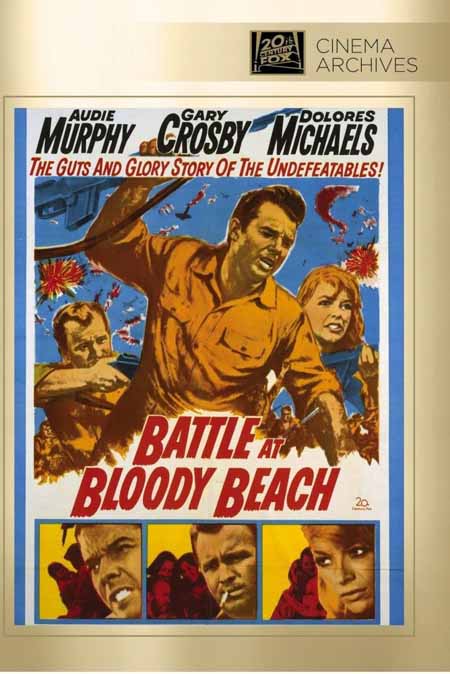Fox has released the 1961 B WWII movie Battle at Bloody Beach as as burn-to-order Cinema Archive title. The film stars Audie Murphy, who was trying to expand his horizons beyond the Western movie genre. This was only Murphy’s second WWII movie, following his autobiographical 1955 hit To Hell and Back which chronicled how he became the most decorated soldier in American history. The story finds Murphy cast as Craig Benson, an American civilian who volunteers to serve with the U.S. Navy on highly dangerous missions to rescue American refugees stranded on Japanese-occupied islands in the Pacific. Working with local partisans, Benson succeeds in saving any number of U.S citizens who have been hiding in mountainous areas. Although hailed as a hero and placed on Japan’s “most-wanted” list, Benson is not motivated by patriotic duty. Rather, he is obsessed with finding his wife Ruth (Dolores Michaels) from whom he was separated when the Japanese invaded the Philippines. Not knowing whether she is alive or dead, Benson tempts fate with his relentless searches on over 34 islands that are under the control of the enemy. On one particular island, he works with his contact, a U.S. serviceman named Marty Sackler (Gary Crosby), who runs a one-man coast-watching operation in addition to helping local resistance forces. The two men rescue some stranded Americans and Benson is overjoyed to find that Ruth is among them. His celebratory mood is short-lived, however, as she explains she has changed dramatically over the two years they have been separated. She has become a gun-toting, high skilled jungle fighter and says she refuses to go back to America with Benson because she is devoted to the cause. Benson suspects another reason for her reluctance to accompany him. He later learns that she has been romantically involved with Julio Fontana (Alejandro Rey), a local guerrilla leader who, unfortunately for Benson, also happens to look like a matinee idol. Sexual tension in bristles in this love triangle, even as the group leads a motley bunch of refugees to a beach to await pickup by a submarine. When the sub is delayed, the group takes refuge in an old beached vessel but are discovered by Japanese forces who launch an attack. The rebels are heavily armed and put up stiff resistance but their cause seems hopeless.
Despite its hackneyed, exploitation film title, Battle at Bloody Beach is an intelligent and reasonably entertaining film. It was clearly designed for the drive-in market and was shot on a low budget on Santa Catalina Island in California, which makes a surprisingly convincing stand in for the Philippine locations. Murphy is stolid and likable, as is Crosby, who gets a few laughs by his evident enjoyment of his coast watching job since it affords him a menage a trois with two lovely young native girls. Dolores Michaels is gorgeous and quite competent as an actress, so one must assume that her film career ended shortly after this movie by her own choice. This film marked the first starring role for charismatic Alejandro Rey, who would go on to a fairly successful career in TV and films before passing away at age 57 in 1987. Ivan Dixon appears as an American boxer caught up in events who decides to fight with the guerrillas. The movie is competently directed by Herbert Coleman, who is best known for serving as associate producer on several Alfred Hitchcock classics. Producer and screenwriter Richard Maibaum was already an old hand at writing action potboilers but the next year his career would skyrocket when he became a long-standing script writer for the James Bond movies. In summary, Bloody Beach is a entertaining and fairly exciting film that demonstrates that the B movie genre could often produce some unheralded gems.
The Fox DVD emphasizes the crisp, sharp B&W cinematography but the the movie is inexplicably presented in pan and scan format even though it was shot in Cinemascope. Whoever is making these decisions at Fox must be living in a time warp. Viewers have long ago accepted the letterbox format for widescreen movies, so why tick off retro movie lovers by altering the original format?

